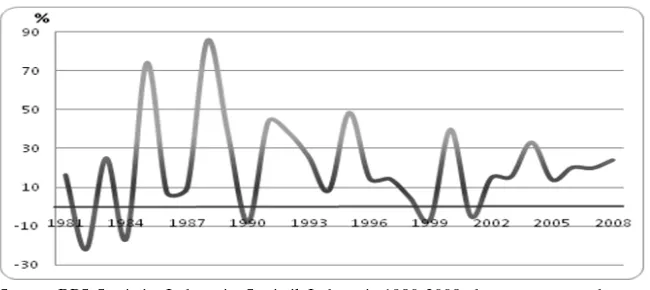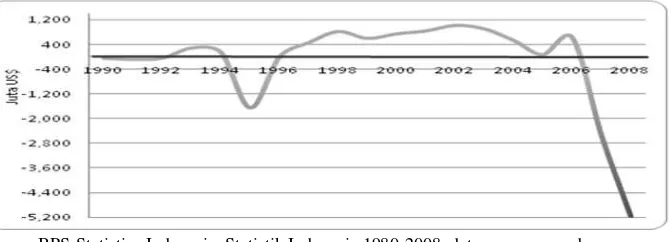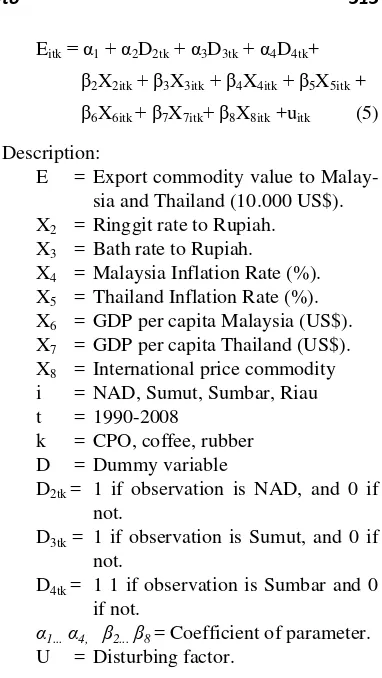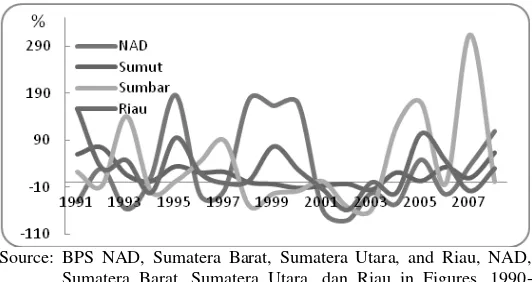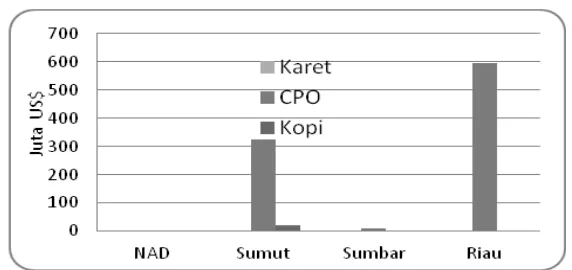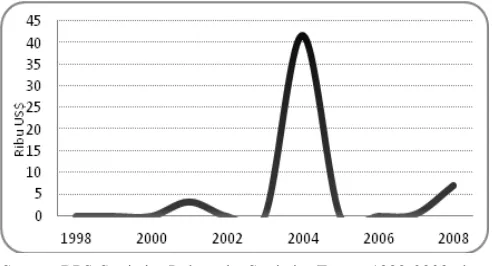Volume 25, Number 3, 2010, 308 – 324
DISTORTION OF CAPACITY ON INTER-REGIONAL TRADE
OF IMT-GT: STUDY CASES ON FOUR SELECTED
PROVINCES IN SUMATRA, INDONESIA)
Benito Rio Avianto1
International Economic Cooperation and Financing of ASEAN Division (benito.ekon@yahoo.com)
ABSTRACT
The objective of the paper was to understand the impact of sub regional economic cooperation, known as the Indonesia-Malaysia-Thailand Growth Triangle (IMT- GT), on trade sector in Indonesia. The approach of research based on export macro information by provinces and commodities.
The method used in the analytical framework was a fixed effect method. The regional study covered Nanggroe Aceh Darussalam, North Sumatera, West Sumatera Barat, and Riau provinces, and the commodities involved CPO, coffee and rubber, with 1990-2008 data series.
Based on pooled regression, the IMT-GT, there was a significant impact on export from the four provinces to Malaysia and Thailand for all based years. One might focus on commodity level that, in fact, CPO was the only one coomodity that had a significant impact within the IMT GT region. In addition, Thai Bath and Malaysian Ringgit, with respect to GDP for both countries, had significant influenced on Export;, especially after the IMT GT endorsed.
Keywords: IMT-GT, Province, export, CPO, coffee, and rubber export, pooled regression
INTRODUCTION1
Economic globalization is a reality faced by many countries in the world today, includ-ing Indonesia. It is as pronounced by President Soeharto in the 2nd Asia-Pacific Economic Coperation (APEC) Leaders Summit in Bogor 1994, "Indonesia has no more choice except taking part of globalization, whether ready or not" (Soesastro, 2004:12). IMT-GT sub-regional cooperation is a form of broader scope than the Sijori (Singapore, Johor and Riau), ie, covering ten provinces in Sumatra,
1 I am grateful to Catur Sugiyanto for his excellent
guidance.
eight states in Malaysia, and fourteen Prov-inces in Southern Thailand.
Establishment of the IMT-GT is essen-tially a follow-up and development of coop-eration between private businessmen from Indonesia, Malaysia, and Thailand which have had historical relations because of the position of the adjacent territory. Development of sub-regional economic cooperation in the IMT-GT is one of government's efforts to improve the welfare of society as equitable and sustainable through increasing utilization of human and natural resources of each region.
sub-regional economic cooperation of Indonesian exports (mainly from provinces in Sumatra to Malaysia and Thailand) are involved in these KESR? How does it affect the main commod-ity export provinces in Sumatra? What are the factors that affect exports to Malaysia, Suma-tra Province and Thailand both in aggregate and broken down by major commodities before and after the IMT-GT?
Selected sector in this research is the trade sector. Macro-regional trade sector was chosen because it can provide 'color' direct influence on the regional economy in Sumatra. Four provinces (Nanggroe Aceh Darussalam/ NAD, West Sumatra, North Sumatra and Riau) are considered to have excellent potential commodities for the trade sector, and also have increased the competitiveness of their exports (ADB, 2007:5). Several reviews fundamental studies in this review were to focus on:
1. The demand side, exports (total demand);
2. Export NAD, North Sumatra, West Suma-tra and Riau provinces;
3. CPO export commodity, coffee, and rubber without distinguishing types and quality;
This study aimed to examine: (i) the impact of economic integration of ASEAN countries in the sub-regional scale of exports of NAD, North Sumatra, West Sumatra, and Riau to Malaysia and Thailand before and after the IMT-GT; (ii) the impact of economic integration of ASEAN countries on a scale Thailand, both in aggregate and by commodity CPO, coffee, and rubber before and after IMT- GT.
The data used comes from a regional macro data of BPS-Statistics Indonesia both central and regional in 1990-2008, especially
for observation of the aggregate value of exports, and commodity data in 1998-2008 according to the CPO, coffee, and rubber. Options review of commodities is based on the superior capacity of Sumatra.
Although many international economic cooperation agreement which amounts to tens of (Ministry of Foreign Affairs, 2007:6), but still limited research on the benefits of interna-tional economic cooperation for Indonesia more over detail to commodities. There is more research examining the impact of international economic cooperation at the state level (aggregative nature).
Simplified hypothesis in this research used in two directions: (i) the alleged difference in aggregate value of both exports and per-commodity CPO, coffee, and rubber from NAD, North Sumatra, West Sumatra, and Riau before and after the IMT-GT; (ii) suspected Ringgit exchange rate, the rates of Bath, Malaysia's inflation, inflation in Thailand, Malaysia's GDP per capita, GDP per capita of Thailand, the international price of CPO com-modity, coffee, and rubber affect the export value of NAD, North Sumatra, West Sumatra, and Riau both in aggregate and by CPO commodity, coffee, and rubber.
OVERVIEW OF LIBRARY AND INFOR-MATION MACRO INTER-REGIONAL TRADE TO MALAYSIA AND THAI-LAND
govern-ment as an entity that provides support facilities.
One study that has been done is research KESR by Jitpiromsri and Kitthaworn (2000) with assistance from ADB, which is about the implications of "Open Regionalism" IMT-GT cooperation of the local economy in Thailand in 1998. The results showed superiority identification of Thailand society in the province of Pattani, Yala, Narathiwat, Satun and Songkla can be compared with Indonesia and Malaysia.
International trade can be defined as trade between countries which in principle is a trade between the two countries covering exports and imports (Tambunan, 2000:1). According to Mankiw (2006:128), exports of a country affected by exchange rates, inflation in the destination countries, and GDP per capita export destination countries. Boediono (1993: 34) said that the direct benefits of international trade are increasing production and producer income, increase employment and skills and to encourage the improvement of the quality of traded goods.
Dosch and Hensengerth (2005) analyzed the sub-regional cooperation in Southeast Asia: the Greater Mekong Basin (GMS). For GMS sub-regional cooperation is needed, aiming for the efforts of overcoming these conflicts. The main objective of GMS coop-eration is to create security and stability in the region. ERIA (Economic Research Institute for ASEAN and East Asia) from 2007 to 2009 has conducted a review of urban spatial development in the GMS, IMT-GT and BIMP-EAGA in the field of manufacturing industry (Koestoer, 2009). Basically ERIA reviewing the broader realism of study to include GMS, IMT-GT and BIMP-EAGA (Brunei, Indonesia Malaysia and the Philippines) and reviewed by Koestoer (2009) on the mechanisms of inter-regional and institutional management in the context of the megalopolis, rather than sector economy, especially for the IMT-GT.
Feng and Genna (2003:14) said that economic integration is defined as a form of collective joint action among several countries to achieve the agreed objectives. This action may include the establishment of free trade area, customs union, to economic union as it has achieved the European Economic Community (EEC). Rodrik (2000), interna-tional economic integration is how to view the world as a market for goods, services, and markets are perfectly integrated production.
As mentioned above, the trade sector is one of the priorities in the IMT-GT coopera-tion. Trade activities are expected to become the motor for regional economic growth. The development of the trade sector from Indo-nesia to Malaysia and Thailand can be seen in Figure 1.
Indonesia’s export growth before and after the issuance of Presidential Decree KESR historically from 1990 to 2008 increases rela-tively. Figure 1 shows that in the years 1980-1992 before the agreed IMT-GT, the value of Indonesian exports to Malaysia and Thailand are moving very slowly, ie below U.S. $ 1,000 million. However, after enacting the Presiden-tial Decree No. 13/2001 concerning the strengthening Sub-regional/KESR Economic Cooperation, Indonesian export experienced a significant increase in the approaching U.S. $ 2,000 million in 1994 and experienced double jump and reached around U.S. $ 4,000 million in 2002.
Figure 3 below shows the development of exports and imports to Malaysia and Thailand during the years 1990-2008. Shown in Figure 3 the development of exports and imports to Malaysia and Thailand are both showing a tendency to increase from year to year.
In the development of Indonesia's trade balance to Malaysia and Thailand in the period 1990-2008, Indonesia's trade pattern was fluc-tuating trend, was not unexpected. This is shown in Figure 4. It appears that starting in 2006, Indonesia's trade balance to Malaysia and Thailand suffered a contraction of up to US$ (-) 5,200 million, meaning the difference between exports to reduce imports to Malaysia and Thailand experienced a huge difference.
BASIC APPROACHES
To “break in” problems and achieve the objectives, of the study used the approach some relevant statistical tests, among others: (i) Average Difference Test and (ii) Regression Analysis of Panel Data. The average difference test is used to refer to the difference in effect before and after the implementation of Decision KESR, especially in IMT-GT (Indonesia, Malaysia and Thailand Growth Triangle). To find out the effect before and after the IMT-GT both on the value of the export value of NAD, North Sumatra, West Sumatra, and Riau both in aggregate and by commodity CPO, coffee, and rubber, the study
Source: BPS-Statistics Indonesia, Statistik Indonesia 1980-2008, data are processed
Figure 1. Progress of Indonesia's exports to Malaysia and Thailand, 1980-2008
Source: BPS-Statistics Indonesia, Statistik Indonesia 1980-2008, data are processed
used the sign test and Wilcoxon rank test, Mann-Whitney (statistics WMW).
Statistical test of WMW, Z
w w )
W (
(1)
Description:
W+ = total export value difference NAD, North Sumatera, West Sumatera, dan.Riau before and after the IMT-GT.
μw+ = value of the average difference in value of exports of NAD, North Sumatera, West Sumatra, and Riau before and after the IMT-GT. σw+ = value export value of standard
deviation difference in NAD, North Sumatra, West Sumatra, and Riau before and after the IMT-GT.
To find out the effect before and after the IMT-GT on the value of the export value of NAD, North Sumatra, West Sumatra, and Riau, both in aggregate and by commodity CPO, coffee, and rubber, along with the factors affecting it, the study used panel data regression analysis. Dummy variables are used to see the impact before and after the IMT-GT.
In general, the basic framework of panel data can be written as follows,
it it it ' it x
y (2)
Where Y is to measure the influence of the t period for i unit. Standard assumptions used in the empirical study states, that is constant for all i and t except - perhaps, to intercept. This can be written as follows,
Source: BPS-Statistics Indonesia, Statistik Indonesia 1980-2008, data are processed
Figure 3. The Value of Indonesia’s Export and Import to Malaysia and Thailand,
1981-2008
Source: BPS-Statistics Indonesia, Statistik Indonesia 1980-2008, data are processed
it explanatory variables, excluding the constant. This means, that the effect of changing x is the same for every unit and every period, but the average of the unit i. may vary from unit j. capture the effects of these variables unique to the individual to-i and constant in time.
In this research, there are 76 provincial export data to an aggregate model and 1999 data for commodity export model. Regression model is an econometric panel data can be written as follows:
1. Aggregate exports of NAD, North Sumatra, West Sumatra, and Riau in the aggregate before and after IMT GT.
Eit = α1 + α2D2i + α3D3i + α4D4i+ β2X2it + West Sumatera, and Riau by commodity of CPO, k
Eitk= α1+ α2D2tk+ α3D3tk+ α4D4tk+
β2X2itk+ β3X3itk+ β4X4itk+ β5X5itk +
β6X6itk + β7X7itk+ β8X8itk +uitk (5)
Description:
E = Export commodity value to Malay-sia and Thailand (10.000 US$). X2 = Ringgit rate to Rupiah. years ie from 1998 to 2008.
NAD, North Sumatra, West Sumatra, and
Riau had the largest fluctuation in export value among other provinces. In addition, Riau also had positive growth trends in exporting its products to Malaysia and Thailand.
As viewing from the side of the growth of export as seen in Figure 6, the study looked into the four provinces has a fluctuating growth in the period 1991-2008. West Sumatra and Aceh have the most diverse growth fluctuations, while in Riau and North Sumatra were relatively stable.
Figure 7 shows the export commodities of the province of Aceh, North Sumatra, West Sumatra, and Riau in the period 1990-2008 especially in CPO, coffee, and rubber. Riau had the largest palm oil exports, followed by North Sumatra and West Sumatra. For of coffee and rubber, the export value was relatively small.
Source: BPS NAD, Sumatera Barat, Sumatera Utara, and Riau, NAD, Sumatera Barat, Sumatera Utara, dan Riau in Figures, 1990- 2008, data are processed.
Figure 5. Export Growth by Provinces to Malaysia and Thailand 1990-2008.
Source: BPS NAD, Sumatera Barat, Sumatera Utara, and Riau, NAD, Sumatera Barat, Sumatera Utara, dan Riau in Figures, 1990- 2008, data are processed.
Figure 8 shows the progress of CPO exports from the province of Aceh, North Sumatra, West Sumatra, and Riau to Malaysia and Thailand during the years 1998-2008. The trend of the CPO export value continues to increase. In the year 2007 CPO exports rose high enough to reach more than U.S. $ 50 million or more than 64 percent of total CPO exports. This shows decree has been able to encourage the export of CPO. Figure 8 refers to the tendency of increase in CPO exports after the issuance of Presidential Decree.
Figure 9 reveals the development of coffee exports from the province of Aceh, North Sumatra, West Sumatra, and Riau to
Malaysia and Thailand in 1998-2008. Sumatra coffee produces two types of coffee, ie Arabica and Robusta. Shown in Figure 9 the value of coffee exports to Malaysia and Thailand showed a tendency to fall.
Compared to CPO and coffee exports, Figure 10 shows the development of rubber exports to Malaysia and Thailand, a relatively small value. Even in certain years such as 1998, 1999, 2003, and 2005 there was no rubber exports to Malaysia and Thailand. Only in 2004 the value of rubber exports to Malaysia and Thailand reached about U.S. $ 40 thousand, which are relatively small compared to CPO and coffee exports.
Source: BPS-Statistics Indonesia, Statistics Export 1998-2008, data are processed.
Figure 7. The Progress of CPO, Coffee, Rubber from NAD, North Sumatra, West Sumatra, and Riau to Malaysia and Thailand, 1990-2008.
Source: BPS-Statistics Indonesia, Statistics Export 1998-2008, data are processed
ANALYSIS OF DIFFERENT TEST AVERAGE EXPORT NAD, NORTH SUMATRA, WEST SUMATRA, AND RIAU TO MALAYSIA AND THAILAND
After doing the calculations for the diffe-rent test average of export value of NAD, North Sumatra, West Sumatra, and Riau obtained the following results as follows.
Hypothesis (Ho) in this study is Ho = 0, ie there is no significant difference of export value, NAD, North Sumatra, West Sumatra, and Riau before and after the IMT-GT. In aggregate there is a significant difference in the total export value, NAD, North Sumatra,
West Sumatra, and Riau to Malaysia and Thailand. This is demonstrated by the signi-ficant value of 2 percent, which values the significance of it was under the limit of α = 5 percent, which means reject Ho.
Table 2 shows the different test results on average between the province of Aceh, North Sumatra, West Sumatra, and Riau to Malaysia and Thailand. Seen that the value of exports from North Sumatra, West Sumatra, and Riau are significantly different at α = 10 percent, where 6.8 percent significance value before and after the IMT-GT. Exports of NAD did not differ significantly before and after the IMT-GT.
Source: BPS-Statistics Indonesia, Statistics Export 1998-2008, data are processed
Figure 9. The Progress of Export Coffee from NAD, Sumut, Sumbar, and Riau to Malaysia and Thailand, 1990-2008.
Source: BPS-Statistics Indonesia, Statistics Export 1998-2008, data are processed
Table 1. Different Test Average Export NAD, North Sumatra, West Sumatra, and Riau to Malaysia and Thailand Before and After IMT-GT
Before - After
Z -3.103a
Asymp. Sig. (2-tailed) .002
a. Based on negative ranks. b. Wilcoxon Signed Ranks Test
Table 2 Different test average by Provinces Before and After IMT-GT
NAD Sumut Sumbar Riau
Z -.365a -1.826a -1.826a -1.826a
Asymp. Sig. (2-tailed) .715 .068 .068 .068
a. Based on negative ranks. b. Wilcoxon Signed Ranks Test
ANALYSIS OF DIFFERENT TEST AVERAGE EXPORT OF CPO, COFFEE, AND RUBBER FROM NAD, NORTH SUMATRA, WEST SUMATRA, AND RIAU TO MALAYSIA AND THAILAND
Having made a calculation of the average difference test of the value of palm oil exports, coffee, and rubber, NAD, North Sumatra, West Sumatra, and Riau obtained the following results.
Table 3 shows the different test average CPO export, coffee, and rubber. Shown in the table significant value of CPO, coffee, and rubber is 13 percent, 72 percent and 65 per-cent, greater than 5 percent error rate. This means accepting Ho, where Ho is no signifi-cant differences in the export of CPO, coffee, and rubber before and after the IMT-GT.
REGRESSION ANALYSIS OF PANEL
DATA EXPORT, NAD, NORTH
SUMATRA, WEST SUMATRA, AND RIAU TO MALAYSIA AND THAILAND
Estimation of panel data regression model to export, NAD, North Sumatra, West Suma-tra, and Riau to Malaysia and Thailand before and after IMT GT get results as shown in Table 4 below.
1. Regression Model Panel Data of Aggregate Export Province
Based on the value of the significant independent variable coefficient, only Malaysia's GDP per capita does not significantly affect exports, NAD, North Sumatra, West Sumatra, and Riau to Malaysia and Thailand in 1990-2008. Other independent variables affect significantly to the export, ie Ringgit exchange rate, the rates Bath, inflation in Malaysia, Thailand, inflation, and dummy variables. Thailand's GDP per capita exports affect significantly but have the error rate of 10 percent.
model significantly influences the export of the province.
Panel data regression model is as follows:
YNAD = 9,96 + 0,00105 Km - 0,011 Kt +
0.17 Im - 0.19 It - 0.0006 GDPt +
0.521 D + u (6)
YSumut = 11,45 0,00105 Km - 0,011 Kt +
0.17 Im - 0.19 It - 0.0006 GDPt +
0.521 D + u (7)
YSumbar = 8,98 0,00105 Km - 0,011 Kt +
0.17 Im - 0.19 It - 0.0006 GDPt +
0.521 D + u (8)
YRiau = 12, 0,00105 Km - 0,011 Kt +
0.17 Im - 0.19 It - 0.0006 GDPt +
0.521 D + u (9)
Interpretation of the estimation of panel data regression model mentioned above is as follows: if there is no influence of the depend-Table 3. Different Test Average Export of CPO, Coffee, and
Rubber Before and After IMT-GT
CPO Kopi Karet
Z -1.503(a) -.357(a) -.447(a)
Asymp. Sig. (2-tailed) .133 .721 .655
a Based on negative ranks. b Wilcoxon Signed Ranks Test
Table 4. Model Regression Model of Aggregate Export of NAD, Sumatera Utara, Sumatera Barat, and Riau to Malaysia and Thailand Before and After IMT-GT
Variabel Coefficient Std. Error t-Statistic Prob.
Ringgit Rate 0.001058 0.000302 3.504790* 0.0008
Bath Rate -0.011302 0.004109 -2.750559* 0.0077
Malaysia Inflation 0.174123 0.047483 3.667020* 0.0005 Thailand Inflation -0.199863 0.041030 -4.871181 0.0000 GDP per capita Malaysia -3.05E-05 0.000196 -0.155435 0.8770 GDP per capita Thailand 0.000599 0.000341 1.757082** 0.0836 Variable dummy 0.521319 0.160695 3.244156 0.0019
Description: *) Significant at level 5 percent, **) Significant at level 10 percent
Export value (independent variable) in log form.
Fixed Effects
NAD--C 8.965086
SUMUT--C 10.45062
SUMBAR--C 7.988485
Unweighted Statistics
R-squared 0.845786 Mean dependent var 11.27521
Adjusted R-squared 0.822060 S.D. dependent var 1.565326 S.E. of regression 0.660300 Sum squared resid 28.33972 Durbin-Watson stat 0.777892 Prob(F-statistic) 0.00000
ent variables in the model (exchange of Bath, Malaysia's inflation, inflation Thailand, Malaysia's GDP per capita, GDP per capita, and dummy variables) then the value of exports to Malaysia and Thailand from NAD = U.S. $ 9.96 million, North Sumatra = U.S. $ 11.45 million, West Sumatra = U.S. $ 8.89 million, and Riau = U.S. $ 12.50 million.
Coefficients of independent variables on panel data regression model, NAD, North increased by one unit, then the exports will decrease by 0.01 percent.
5. When Thailand's GDP per capita increased by one unit, then exports would increase by 0.0006 percent.
6. Influence of the IMT-GT against exports amounting to 0.52 percent.
Based on the estimated regression panel data model can be concluded that the Ringgit exchange rate, the rates of Bath, inflation in Malaysia, Thailand's inflation rate, GDP per capita, and dummy variables significantly affect exports, NAD, North Sumatra, West Sumatra, and Riau in 1990 to 2008. Level of influence is 85 percent.
PANEL DATA REGRESSION ANALYSIS independent variable coefficient, only Malaysian inflation and dummy variables that affect significantly to the export of CPO, NAD, North Sumatra, West Sumatra, and Riau to Malaysia and Thailand in 1998-2008. Other independent variables did not significantly affect the export, ie, the ringgit exchange rate, the rates of Bath, Thailand's inflation rate,
Interpretation of the processing Eviews 4.0 in Table 5 are as follows. Coefficient of determination (adjusted R-squared) shows the independent variables in the model can explain 71 percent or strong enough for the factors that affect exports, NAD, North Sumatra, West Sumatra, and Riau to Malaysia and Thailand, while the rest equal to 29 percent is influenced by factors outside the model. The value of the significance of dummy variables showed no significant difference in CPO exports, NAD, North Sumatra, West Sumatra, and Riau to Malaysia and Thailand before and after the IMT-GT. While the magnitude of the F-statistic 0.0000 shows the overall independent variables in the model significantly influences the export of the province. Panel data regression model is as follows,
YNAD = 1,059 + 1,21 Im + 2.56 D + u (10)
YSumut = 1,286 + 1,21 Im + 2.56 D + u (11)
YSumbar = 1,065 + 1,21 Im + 2.56 D + u (12)
Interpretation of the estimation of panel data regression model can be explained. First, if there is no influence of the dependent variables in the model (exchange of Bath, Malaysia's inflation, inflation in Thailand, Malaysia's GDP per capita, GDP per capita, and dummy variables), then the value of exports to Malaysia and Thailand in the period 1998 - 2008 is the NAD = U.S. $ 1.059 million, North Sumatra = U.S. $ 1.286 million, West Sumatra = U.S. $ 1.065 million, and Riau = U.S. $ 1.315 million. Coefficients of independent variables on panel data regression model CPO export NAD, North Sumatra, West Sumatra, and Riau can be interpreted as follows:
1. If Malaysia's inflation rose by 1 percent, then the exports will increase by 1.12 percent
2. Influence of the IMT-GT on CPO exports amounted to 2.56 percent
Second, based on the estimated regression panel data model can be concluded that the CPO export Malaysian inflation and dummy variables significantly affect exports, NAD, North Sumatra, West Sumatra, and Riau. Level of influence is 74 percent.
Panel data regression model coffee exports. Results of processing coffee for export from the province of Aceh, North Sumatra, West Sumatra, and Riau to Malaysia and Thailand using Eviews 4.0 help get the international price of coffee is only affecting exports to Malaysia and Thailand. While other independent variables did not affect signifi-cantly to the export of coffee to Malaysia and Thailand. Given the low value of coefficient of Table 5 Regression Model CPO exports, NAD, North Sumatra, West Sumatra, and Riau to
Malaysia and Thailand Before and After IMT-GT
Read phonetically
Variabel Coefficient Std. Error t-Statistic Prob.
Kurs Ringgit 0.001047 0.001373 0.762493 0.4569
Kurs Bath 0.018147 0.030786 0.589461 0.5638
Inflasi Malaysia 1.121783 0.470480 2.384334* 0.0298 Inflasi Thailand -0.641071 0.404364 -1.585383 0.1324 GDP per Kapita Malaysia -0.002617 0.001541 -1.698332 0.1088 GDP per Kapita Thailand 0.003415 0.003780 0.903227 0.3798 Harga internasional -0.001768 0.009681 -0.182640 0.8574 Variabel dummy 2.563575 0.894913 2.864608* 0.0112
Description: *) Significant at level 5 percent
Export CPO (independent variable) in log form.
Fixed Effects
NAD--C 9.598585
SUMUT--C 11.86781
SUMBAR--C 9.652886
RIAU--C 12.15419
Unweighted Statistics
R-squared 0.711762 Mean dependent var 16.48516
determination (adjusted R-squared) and the number of independent variables are not sig-nificant, the estimation of panel data regres-sion model coffee exports cannot be done. This happens because due to Malaysia and Thailand is not the main export of coffee from Aceh Province, North Sumatra, West Sumatra, and Riau. independent variables and the low adjusted R-squared. Therefore, panel data estimation model cannot be made of rubber exports. Similarly, coffee exports, Malaysia and Thailand is not the main export of rubber from the province of Aceh, North Sumatra, West Sumatra, and Riau.
CONCLUSIONS AND POLICY IMPLICATIONS
Conclusions
Conclusion the analysis of the influence of sub-regional economic cooperation in the Indonesia-Malaysia-Thailand Growth Triangle (IMT-GT) toward the trade sector in Indonesia are as follows.
1. Sub-regional economic cooperation (KESR) IMT-GT has a positive effect on CPO, which had significant influence before and after the Presidential Decree. No.13/2001 concerning the Strengthening of the IMT-GT KESR.
3. The factors which significantly influence the export of NAD, North Sumatra, West Sumatra, and Riau to Malaysia and
Thai-land in the IMT-GT are KESR Ringgit exchange rate, exchange of Bath, Malay-sia's inflation, and GDP per capita of Thailand, while the factor which signifi-cantly influence Malaysia's CPO export is inflation.
Policy Implications
Based on the above conclusion, it can be interpreted as following policy implications. 1. Reviewing potential, NAD, North Sumatra,
West Sumatra, and Riau, and all provinces in Sumatra generally can utilize IMT-GT cooperation that was initiated Government. 2. The necessity of recording detailed data on the origin of the flow of goods (rules of origin) between the regions to see the impact of international economic coopera-tion for the region.
3. Similar research should be developed for review value of import port value to encourage of the achievement of inter-region, particularly focused on sub-regional cooperation.
4. Regional policy is needed (relevant permits and regulations) to support and encourage increased inter-regional export.
REFERENCES
Apriliani, Wiwien, Kevinder, Fitriady, Mu-hammad, 2008. Teori Regionalism [Regionalism Theory], Central Strategic for International Studies, Jakarta.
ASEAN Secretariat, http://www.aseansec.org, accessed each month in 2008 and 2009. Asian Development Bank, 2007, “Building A
Dynamic Future, Roadmap Development of IMT-GT 2007-2011”, Report, IMT-GT Secretariat and Asian Development Bank. Philipines.
Asian Development Bank,
Badan Pusat Statistik, 2008. Statistik Indonesia 1990-2008 [Indonesian Statistic 1990-2008], Jakarta, Indonesia: BPS.
Badan Pusat Statistik, 2008, Kajian Komoditas Unggulan 2008 [Main Commodity Sudies 2008], Jakarta, Indonesia: BPS.
Badan Pusat Statistik [Center of Statistic Agency], http://www.bps.go.id, accessed each month in 2008 and 2009.
Baltagi, Badi H., 2005. EconometricsAnalysis of Panel Data Third Edition. USA: John Wiley.
Bhakti, Anwar, Luhulima, Sungkar, dan Ina-yanti, 2008. Masyarakat Asia Tenggara Menuju Komunitas ASEAN 2015 [South East Asia Society to ASEAN Community 2015], P2P-LIPI dan Pustaka Pelajar, Yogyakarta.
Bank Indonesia, http://www.bi.go.id, accessed each month in 2008 and 2009.
Boediono, 1993. Pengantar Ilmu Ekonomi No. 3: Ekonomi Internasional Seri Sinopsis [Introduction to Economics No. 3: International Economics Synopsis Series]. Yogyakarta: BPFE.
BPS [Centre of Statistic Agency] Kepulauan Riau, Kepulauan Riau Dalam Angka 2005-2008 [Riau Archipelago in Numbers 2005-2008], BPS Kepulauan Riau.
BPS [Centre of Statistic Agency] NAD, Aceh Dalam Angka 1990-2008 [Aceh in Numbers 1990-2008], BPS NAD.
BPS [Centre of Statistic Agency] Riau, Riau 1990-2008], BPS Sumatera Barat.
BPS [Centre of Statistic Agency] Sumatera Utara, Sumatera Utara Dalam Angka 1990-2008 [North Sumatera in Numbers 1990-2008], BPS Sumatera Utara.
Dajan, Anto, 1991, Pengantar Statistik Jilid II [Introduction to Statistics 2nd Edition], Cetakan Keempat Belas, LP3ES, Jakarta. Departemen Luar Negeri, 2007, “ASEAN
Selayang Pandang”, Laporan [ASEAN at Glance, Report], Direktorat Jenderal ASEAN, Departemen Luar Negeri, Jakarta.
Departemen Pertanian [Department of Agriculture], http://www.deptan.go.id, accessed each month in 2008 and 2009. Direktorat Jenderal Kerjasama Perdagangan
Internasiomal, Departemen Perdagangan [General Directorate of International Trade Cooperation, Department of Trade], http://www.kpi.degdag.go.id, accessed each month in 2009.
Dosch, Jorn dan Hensengerth, Oliver. 2005, Subregional Cooperation in the Southeast Asia: the Mekong Basin, Brill, Leiden, Netherland.
ERIA (Economic Research Institute for ASEAN and East Asia), ERIA: The Progress Report, June 2009, Jakarta. Feng, Yi dan Genna, Gaspare M, 2003, “Re
-gional Integration and Domestic Institutional Homogeneity, A Compara-tive Analysis of Regional Integration in the Americas, Pacific Asia and Western Europe” Review of International Political Economy Vol. 10, No. 2, May 2003, Taylor and Francis Ltd, United Kingdom. Gajdos, Peter (ed.) (2008), Regional
Dispari-ties in Central Europe, Slovenska Ko-misia pre UNESCO, NK-MOST Brati-slava, Slovak.
Gujarati, Damodar, 2004, Basic Econometrics, The McGraw-Hill Company. Fourth Edition, London.
IMT-GT Secretariat, http://www.imtgt.org, accessed each month in 2009.
Jhingan, M. L, Ekonomi Pembangunan dan Perencanaan [Development Economy and Planning]. 1999. PT. Raja Grafindo Persada, Jakarta.
Jitpiromsi, Srisompob dan Kitthaworn, Piya, 2000, “The Indonesia-Malaysia-Thailand Growth Triangle (IMT-GT) Project, Implication of “Open Regionalism” to the Local Economy” Songklanarin Journal of Sciences and Humanities Vol. 6 No. 1, Jan-April 2000, Bangkok.
Kementerian Koordinator Bidang Perekonomian [Ministry of Coordinator of Economy], http://www.eko.go.id, accessed each month in 2008 and 2009. Koestoer, Raldi Hendro, 2009, “Emerging
Issues on Megalopolis Spatial Develop-ment in Urban-Fringe Disparities: Per-spectives on IMT Cases”, Lecture Notes on Megalopolis Spatial Planning-Man-agement, Jakarta.
Krugman, Paul R. dan Obstfeld, Maurice, 2004, Ekonomi Internasional, Teori dan Kebijakan (Terjemahan) [International Economy, Theory, and Implementation], PT. Nagarita Dinamika, Jakarta.
Lim, Linda, 1996, ASEAN New Modes of Economic Cooperation, South East Asia in the New World Order: The political Economy of a Dynamic Region, St. Martin Press, New York.
Muhklis, Imam, 2009, “Analisis Dampak Integrasi Ekonomi ASEAN Terhadap Permintaan Impor Industri Manufaktur Indonesia Tahun 1980-2005” [Analysis of The Impact of ASEAN Integration Economi Towards Indonesian Demand on Manufacturing Industry Import 1980-2005], Paper, Fakultas Ekonomi
Universitas Brawijaya,
http://www.fe.ub.ac.id/, Malang,
Ooi, Giok-Ling, 1995, “The Indonesia -Malaysia-Singapore Growth Triangle: Subregional Economic Cooperation and
Integration”, Geo-Journal Vol. 12 No. 7, 1995, Singapore.
Pusat Kerjasama Internasional, Departemen Keuangan [Center of International Cooperation, Department of Finance], http://www.pksi.depkeu.go.id, accessed each month in 2009.
Republik Indonesia, 2001, Keputusan Presi-den Republik Indonesia Nomor 13 Tahun 2001 Tentang Tim Koordinasi Kerjasama Ekonomi Subregional [President Settlement of Republic of Indonesia Number 13 Year 2001 on Coordination Team of Subregional Economy Cooperation], Kementerian Koordinator Bidang Ekonomi dan Keuangan, Jakarta. Rodrik, Dani. 2000. “How Far Will
International Economic Integration Go” Journal of Economic Perspective, Volume 14 No. 1, 2000, Harvard University, USA. Sahman, Andi. 2007, “Kerjasama Ekonomi
Regional” [Cooperation of Sub-Regional Economy], Bulletin Edisi-47/KPI/ 2007, Direktorat Jendral Kerjasama Perdagangan Internasional, Departemen Perdagangan, Jakarta. Salvatore, 2004. Ekonomi Internasional
(Terjemahan) [International Economics], PT. Gelora Aksara Pratama, Jakarta. Santoso, Ferry, Menguji Implementasi Free
Trade Zone (FTZ) [Testing Free Trade Zone (FTZ) Implementation]. Kompas, 1 Juni 2009.
Sekretariat Negara [Bureau of Nation], http://www.setneg.go.id, accessed each month in 2009.
Sjafrizal, 2008. Ekonomi Regional Teori dan Aplikasi. Baduose Media, Padang.
Soesastro, Hadi, 2004. Dari Perdagangan Bebas Menjadi Pasar Bebas ASEAN. Penerbit Central Strategic for International Studies. Jakarta.
Regional-ization, and All of Them]. Central Strategic for International Studies. Jakarta. Supranto, J. 1988. Statistik Deskriptif [Descriptive Statistics]. Airlangga. Jakarta.
Tambunan, Tulus. 2000. Perdagangan Inter-nasional dan Neraca Pembayaran, Teori dan Temuan Empiris [International Trade and Payment Balance, Theory and Empirical Evidence]. LP3ES, Jakarta.
Todaro, MP, 2006. Development Economics. Longman Inc Ninth Edition, England.
